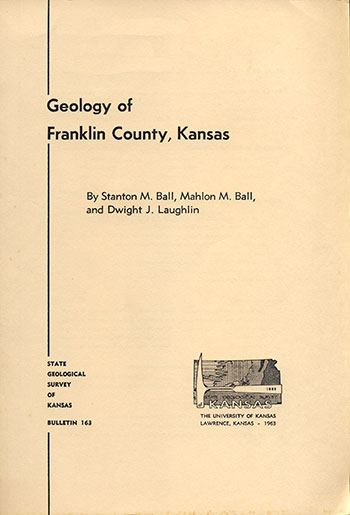Geology of Franklin County, Kansas
by Stanton M. Ball, Mahlon M. Ball, and Dwight J. Laughlin

Originally published in 1963 as Kansas Geological Survey Bulletin 163. This online version has been created because the published version is currently out of print. This is, in general, the original text as published in 1963. The information has not been updated.
You may also wish to visit our web site on the Franklin County geologic map.
Abstract
Rocks exposed in Franklin County have an aggregate thickness of about 700 feet and all are sedimentary. Bedrock of Late Pennsylvanian (Missourian and Virgilian) age comprises mostly shale, sandstone, limestone, and siltstone; the section extends from the Chanute Shale at the base to the Doniphan Shale Member of the Lecompton Limestone at the top. These strata are nearly flat lying; dips approximate 10 to 30 feet per mile.
Lateral continuity of thin stratigraphic units is characteristic although the Wyandotte Limestone formation, absent in the western half of the county, and the locally absent Toronto Limestone, Snyderville Shale, and Leavenworth Limestone Members of the Oread Limestone are exceptions. Facies change is thought to have been the causative factor in the former case, that of the Wyandotte Limestone, whereas faulting and erosion were probably principal causes in the latter case. Most of the bedrock represents sediment deposited in marine and marine-non-marine, or mixed, environments. Surficial deposits of Neogene age comprise mostly alluvium and loess and are exclusively nonmarine.
Franklin County lies within the Forest City Basin. Strata exposed in the county are a small part of the Prairie Plains Monocline, which dips westwardly and northwestwardly away from the Ozark Dome area of Missouri. Numerous local and minor flexures are superimposed on the regional structure. Faulting is uncommon, but two faults affecting the upper part of the Lawrence Shale, the Oread Limestone, and the lower part of the Kanwaka Shale, were mapped in the northwest part of the county. Vertical displacement ranges from approximately 15 to 40 feet. Tracing of the faults is possible only for distances of about a mile; the trend of fault traces ranges from generally north-south to generally northeast-southwest. A coal "conglomerate" thought previously to be largely the result of erosion and redeposition is attributed herein to structural phenomena.
Alluvial deposits in the Marais des Cygnes and Pottawatomie River valleys yield large supplies of ground water and constitute the most important aquifers in the area. Bedrock aquifers are scant in eastern Franklin County but Douglas Group sandstone beds are commonly suitable aquifers in western Franklin County. Oil, limestone, sand and gravel, coal, and shale are other mineral resources exploited in Franklin County.
Data upon which the report is based include about 200 well logs, logs of 2 test holes, and records of 100 measured sections.
Kansas Geological Survey, Geology of Franklin County
Web version July 2002. Original publication date Jun. 1963.
Comments to webadmin@kgs.ku.edu
The URL for this page is http://www.kgs.ku.edu/General/Geology/Franklin/index.html